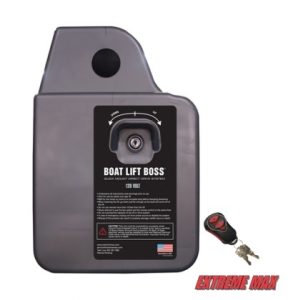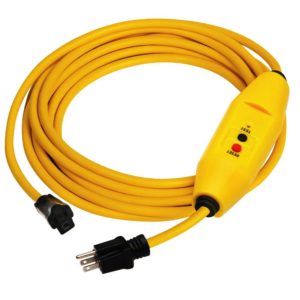Power Options for Boat Lift Motors
Boat lift Motors are covered in this 2 part series. We discuss the different types of operating systems for boat lift motors. Installing a boat lift motor makes your life so much easier. If you can operate a garage door opener, you can run a boat lift motor.
You have three choices to consider for powering a boat lift motor.
- An A.C. operated system;
- A 12V system; Or
- A 24V system.
PWS does not usually recommend an A.C. powered system. Why? It usually means running an extension cord to the motor. Your safety and the safety of the people near you are our primary concern.
Using an A.C. operated lift motor means the extension cord(s) and the connections will be exposed to the elements. These include – Rain, morning dew, splashing from waves, and the list goes on. As a result, there is a potential to expose people to ESD. For a further explanation read this article.
You could be endangering children (or grandchildren) and even your neighbors to electrical shocks. ESD can be deadly and not only threatens swimmers but the people who attempt to rescue them.
Beside safety reasons what other dangers are there?
First, some background info. The smaller the Gauge (Ga.) size, the heavier the wire is. Thus, a 12 gauge wire has a “heavier” wire than an 18 Ga. Typical household extension cords – those brown or white cords – are 18 – 20 Guage (Ga). The wiring in your house is a 14 Ga. 12 Ga. is used in kitchens and bathrooms due to higher amperage requirements. A smaller diameter wire will have a higher resistance to current flow. Thus, more heat is generated in the wire and connections. You want the least amount of heat as possible.
What is Voltage Drop?
The electrical source you use usually will be a circuit run underground or along poles to a power box near the water. At this point, you probably are thinking – “So what, I’ll just run an extension cord to the motor.” On the bay of Green Bay and the Door County peninsula, in particular, you may be looking at the need for a 100’-200’ extension cord. This likely means a second extension cord and more voltage drop. This will get the power across the shoreline to the location of the motor. This presents some problems.
In reality, the longer the extension cord is, the more “voltage drop” will occur. Think of it this way – to turn that motor you need a specific voltage (110V) and amperage. If you experience a voltage drop due to the length of the extension cord, it will require more amperage or current flow make up for the loss in voltage to operate that motor. This situation causes wires to heat up and motors to run hotter. An overheated motor will trip the breakers and damage the motor.
If you’re starting at 110 volts and the voltage drops 3%, it won’t matter to a small appliance or light bulb that the voltage is now 117 volts. However, if you plug in a 100-foot extension cord, the voltage will drop about 6 percent to 104 volts. The motor will run hotter.
Motors generally need heavier gauge wires, in this case, 12 Ga. You would not plug a window air conditioner into those “brown” 18-20 Ga. extensions cord you find at the supermarket. Even a short 4 ft cord like that will almost instantly trip a breaker – IF you are lucky. A fire will occur if you are not so fortunate.
Motors and Extension Cords do not mix well.
Voltage drops can cause loss of efficiency, and this will mean a shorter life span for the motor. It is essential to use the right gauge of wire when running wires for a long distance and keep the cords as short as possible with as few connections as possible.
Electrical cord Guidelines
The best practice is don’t use an extension cord if you don’t have to. Since this isn’t always practical, follow these guidelines for using extension cords with motors to minimize voltage drop:
- Use a GFCIs, or Ground Fault Circuit Interrupters to disconnect power if a potentially dangerous situation occurs. A GFCI interpreter will instantly respond, preventing possible electrocution-related accidents.
- Always use the shortest extension cord possible.
- Use only one cord (there is a voltage drop across the connectors also)
- Use the heaviest Ga. possible – usually a 12 Ga. wire.
- Route extension cords safely and securely. Never place them where they will be damaged or drop into the water.
- If more than one cord is required, use the same on both cords
- Use only extension cords rated for outdoor UV resistance.
- Protect the connectors from the water.
- Do not use damaged cords. Watch out for electrical tape on extension cords.
These are important safety considerations. Choosing the right wire for the job is a critical safety measure.
The best practice is don’t use an extension cord if you don’t have to.
About 50 people die, and 270 people are injured each year when extension cords are strung together.
In part two of this series, we will discuss the two variations for D.C. motors.
Do you have a friend that may be interested in this information? Please share a link to this page with them.
Need Help Selecting a Boat Lift Motor?
Contact Pier & Waterfront Solutions Today!
PWS is located at 7325 St. Hwy 57. That’s 1 mile North of County MM (Hwy 42) and 3 miles South of Sturgeon Bay at the Idlewild Road intersection.
Our staff is here year-round to assist you.







